9 Herbal Teas For Menopause
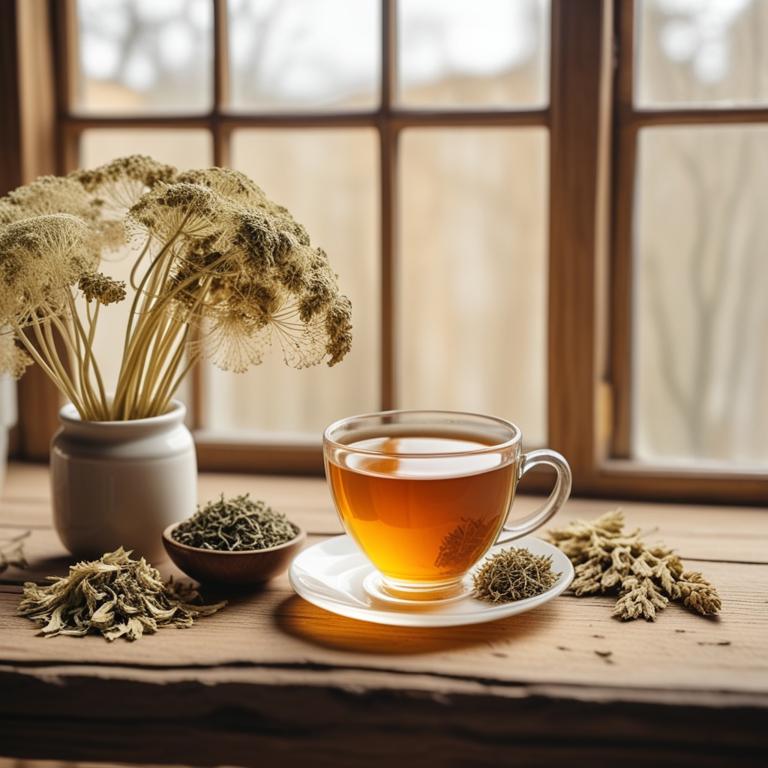
Herbal teas can be a natural and effective way to relieve menopause symptoms.
During menopause, women experience hormonal changes that can lead to hot flashes, mood swings, and sleep disturbances. Herbal teas, made from plants like Valeriana officinalis, Lavandula angustifolia, and Zingiber officinale, can help alleviate these symptoms. Valerian root, for example, is known for its calming effects and can promote a good night's sleep, reducing the frequency and severity of hot flashes.
Lavender tea, on the other hand, has a soothing effect on the nervous system, helping to ease anxiety and promote relaxation. Ginger tea, made from Zingiber officinale, has anti-inflammatory properties that can help reduce pain and discomfort associated with menopause. By incorporating these herbal teas into your daily routine, you can experience a range of benefits, including improved sleep quality, reduced stress levels, and a sense of calm and well-being.
This can, in turn, improve your overall quality of life and help you manage the physical and emotional changes associated with menopause.
- 1. Valeriana officinalis
- 2. Lavandula angustifolia
- 3. Zingiber officinale
- 4. Cimicifuga racemosa
- 5. Melissa officinalis
- 6. Ginkgo biloba
- 7. Passiflora incarnata
- 8. Avena sativa
- 9. Angelica sinensis
1. Valeriana officinalis
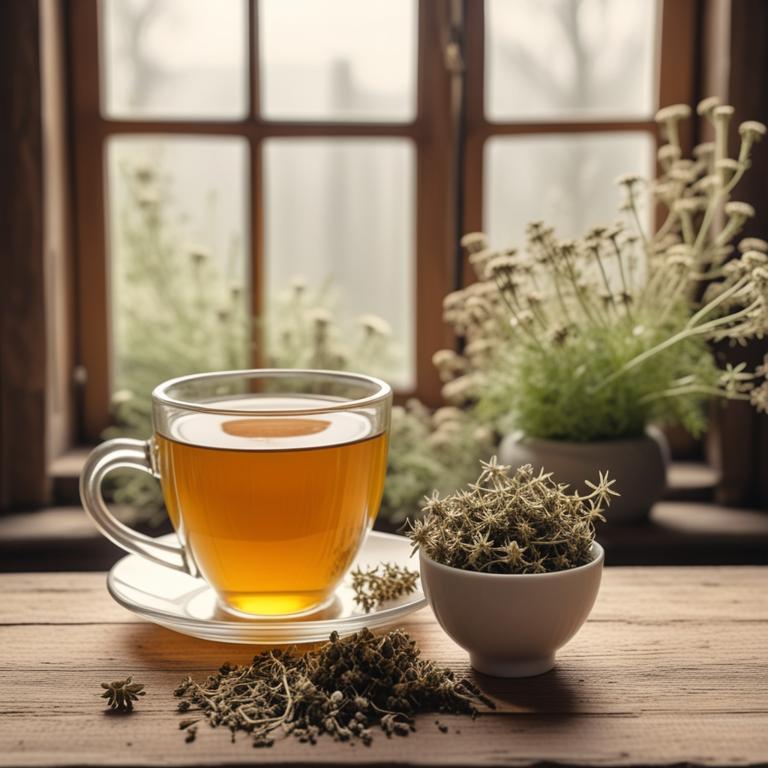
Valeriana officinalis teas contains a group of bioactive constituents, including valepotriates and valeoptenates, which are known to have a sedative effect on the nervous system.
This sedative effect can help alleviate hot flashes, one of the most common symptoms of menopause, by reducing the frequency and intensity of these episodes. Valerian root teas also contain isovaleramide, a compound that has been shown to have a positive effect on the body's hormonal balance, which can help regulate the symptoms of menopause. Additionally, valerian root contains antioxidants, such as hesperidin and quercetin, which can help protect the body from oxidative stress and inflammation, common issues during menopause.
By reducing stress, regulating hormonal balance, and fighting oxidative stress, valerian root teas can provide relief from menopause symptoms.
- Gather 1 cup of fresh or dried Valeriana officinalis roots, 1 cup of boiling water, and a tea infuser or a heat-resistant cup.
- Measure 1-2 teaspoons of Valeriana officinalis roots and place them in the tea infuser or directly into the heat-resistant cup.
- Pour boiling water over the Valeriana officinalis roots and let it steep for 5-7 minutes.
- Strain the tea into a cup using the tea infuser or a piece of cheesecloth and discard the roots.
- Drink 1 cup of Valeriana officinalis tea 2-3 times a day to help alleviate menopause symptoms.
2. Lavandula angustifolia

Lavandula angustifolia teas contains the bioactive constituents linalool and linalyl acetate, which are responsible for its therapeutic effects.
These compounds have a calming effect on the body, which can help alleviate hot flashes and night sweats associated with menopause. The tea also contains apigenin, a flavonoid that has been shown to have estrogen-like properties, which can help balance hormone levels during menopause. Additionally, the tea's antioxidant properties can help reduce inflammation and promote overall health.
By reducing stress and promoting hormonal balance, Lavandula angustifolia teas may provide relief from menopausal symptoms.
- Gather 1 cup of dried Lavandula angustifolia flowers and a large bowl.
- Heat 2 cups of water in a pot, then remove from heat.
- Add 1/4 cup of dried flowers to the hot water and let steep for 5-7 minutes.
- Strain the liquid into a cup and discard the flowers.
- Drink the tea 2-3 times a day to help with menopause symptoms.
3. Zingiber officinale

Zingiber officinale teas contains active constituents like gingerols and shogaols, which have anti-inflammatory properties that help with menopause symptoms.
These compounds work by reducing inflammation in the body, which is often linked to hot flashes, night sweats, and mood swings during menopause. The antioxidant properties of ginger help protect the body from oxidative stress, further alleviating symptoms of menopause. Ginger also helps to regulate hormones and improve digestion, which can lead to a reduction in symptoms like bloating and mood swings.
By reducing inflammation and regulating hormones, Zingiber officinale teas can provide relief from menopause symptoms.
- Gather 1 cup of boiling water, 1 tablespoon of fresh ginger root (Zingiber officinale), and a tea strainer or infuser.
- Peel the ginger root and slice it thinly. Place the sliced ginger into the tea strainer or infuser.
- Steep the ginger in the boiling water for 5-7 minutes. You can adjust the steeping time to your liking.
- Strain the tea into a cup and discard the ginger. Add honey or lemon to taste, if desired.
- Drink the tea 2-3 times a day, preferably before meals, to help alleviate menopause symptoms.
Zingiber Officinale Tea on Amazon
FGO Organic Ginger Tea, 100 Count, Eco-Conscious Tea Bags, Caffeine Free, Packaging May Vary (Pack of 1)
Disclaimer: We earn a commission if you click this link and make a purchase at no additional cost to you.
4. Cimicifuga racemosa
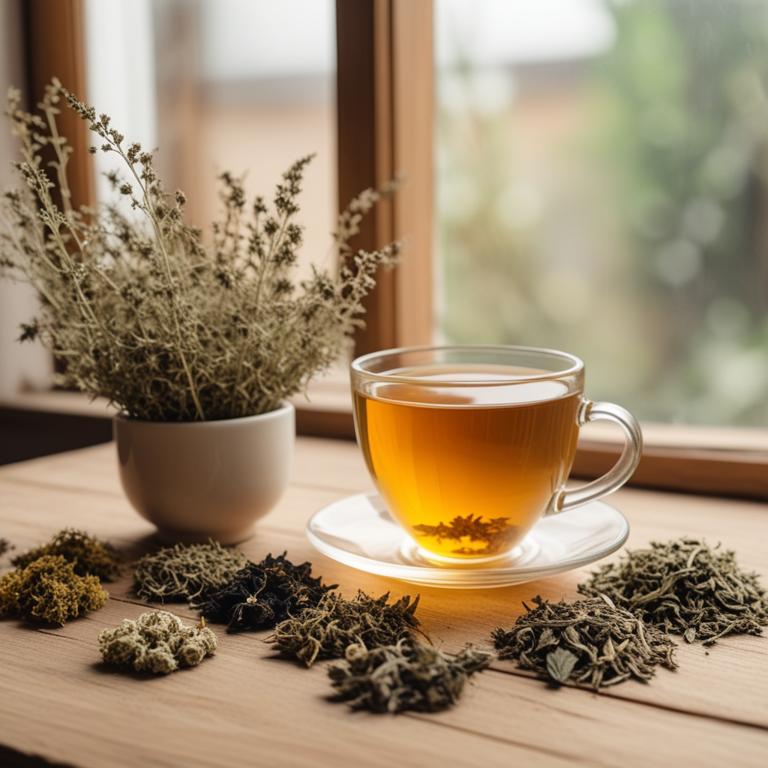
Cimicifuga racemosa teas contains bioactive constituents such as ferulic acid, flavonoids, and lignans.
These compounds have anti-inflammatory and antioxidant properties that help to soothe hot flashes and night sweats associated with menopause. The ferulic acid in Cimicifuga racemosa also has a sedative effect on the nervous system, which can help to reduce anxiety and mood swings common in menopause. The lignans in Cimicifuga racemosa have estrogen-like properties that can help to balance hormone levels and alleviate symptoms such as vaginal dryness and mood changes.
By reducing inflammation and promoting relaxation, Cimicifuga racemosa teas can provide relief from menopause symptoms and improve overall well-being.
- Gather 1 cup of dried Cimicifuga racemosa root, 1 cup of boiling water, and a tea infuser.
- Measure 1 tablespoon of dried root and place it in the tea infuser.
- Steep the root in boiling water for 5-7 minutes.
- Strain the tea into a cup and discard the root.
- Drink the tea 2-3 times a day to help alleviate menopausal symptoms.
5. Melissa officinalis

Melissa officinalis teas contains rosmarinic acid, a potent antioxidant that helps to alleviate symptoms of menopause.
This compound has anti-inflammatory properties, which can reduce hot flashes and night sweats that often accompany menopause. Melissa officinalis also contains flavonoids, such as kaempferol and quercetin, which have a sedative effect and can help regulate mood swings. The tea's high concentration of citral, a natural hormone balancer, can also help to ease hormonal imbalances that lead to menopausal symptoms.
By incorporating Melissa officinalis tea into their daily routine, women may find relief from the discomforts of menopause.
- Gather 1 cup of boiling water and 1 tablespoon of dried Melissa officinalis leaves.
- Measure 1 teaspoon of dried Melissa officinalis leaves and place it in a tea infuser or a small muslin bag.
- Steep the Melissa officinalis leaves in the boiling water for 5-7 minutes, then remove the leaves from the water.
- Strain the tea into a cup and add honey or lemon to taste, if needed.
- Drink the tea 2-3 times a day to help manage menopause symptoms, such as hot flashes and mood swings.
6. Ginkgo biloba

Ginkgo biloba teas contains flavonoids and terpenoids as its bioactive constituents.
These compounds help improve blood flow to the brain, which is beneficial for hot flashes and night sweats during menopause. The flavonoids, particularly quercetin, kaempferol, and isorhapontigenin, have antioxidant properties that help reduce inflammation and protect the body from oxidative stress. The terpenoids, especially bilobalide and ginkgolides, have anti-inflammatory and vasodilatory effects that help alleviate symptoms such as mood swings and vaginal dryness.
By regulating estrogen levels and improving blood circulation, Ginkgo biloba teas can help alleviate symptoms associated with menopause.
- Gather 1 cup of boiling water and 1 teaspoon of dried Ginkgo biloba leaves.
- Measure 1 tablespoon of dried Ginkgo biloba leaves and put it in a tea infuser.
- Pour the boiling water over the tea leaves in the infuser.
- Steep for 5-7 minutes, then remove the tea infuser.
- Strain the tea and drink 1 cup, 2-3 times a day, for menopause relief.
7. Passiflora incarnata
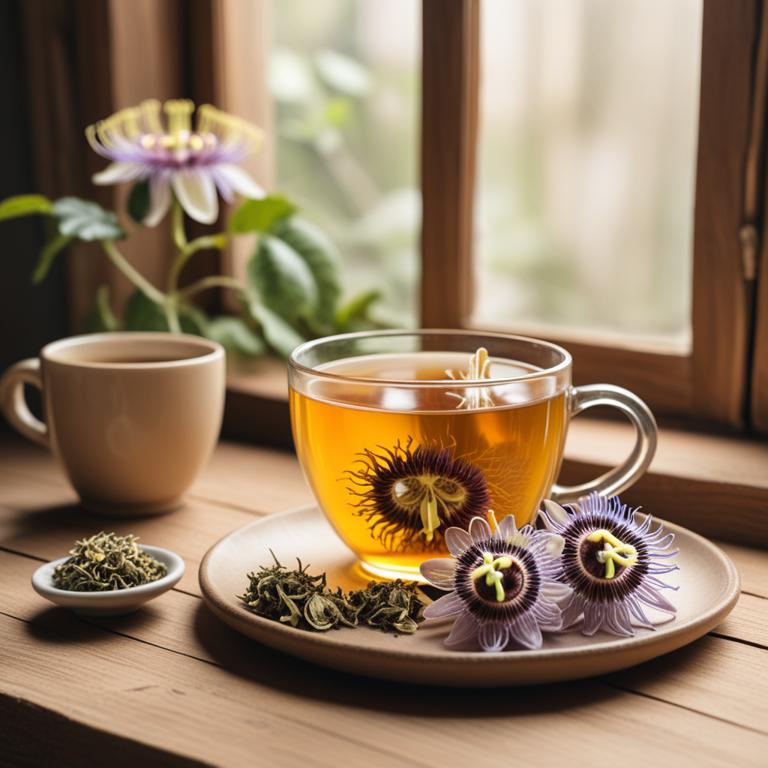
Passiflora incarnata teas contains flavonoids, alkaloids, and other bioactive compounds that help alleviate menopause symptoms.
The flavonoids, particularly flavonol glycosides and kaempferol, have anti-inflammatory and antioxidant properties, reducing hot flashes and night sweats. The alkaloids, such as passiflorine and harmine, act as a sedative, promoting relaxation and reducing anxiety. The tea's antispasmodic properties, due to the presence of flavonoids and alkaloids, help ease menstrual cramps and other menopause-related discomforts.
Regular consumption of Passiflora incarnata tea may provide relief from sleep disturbances and other menopause symptoms, promoting a better quality of life.
- Gather 1 cup of dried Passiflora incarnata flowers and 1 cup of boiling water in a heat-resistant cup.
- Steep the dried flowers in the boiling water for 5-7 minutes, then strain the mixture using a fine-mesh sieve into another cup.
- Add 1 tablespoon of honey to the tea, if desired, and stir well to dissolve.
- Drink the tea 2-3 times a day, or as directed by a healthcare professional, to help alleviate menopause symptoms.
- Store any leftover tea in the refrigerator for up to 24 hours, and reheat as needed before consumption.
8. Avena sativa
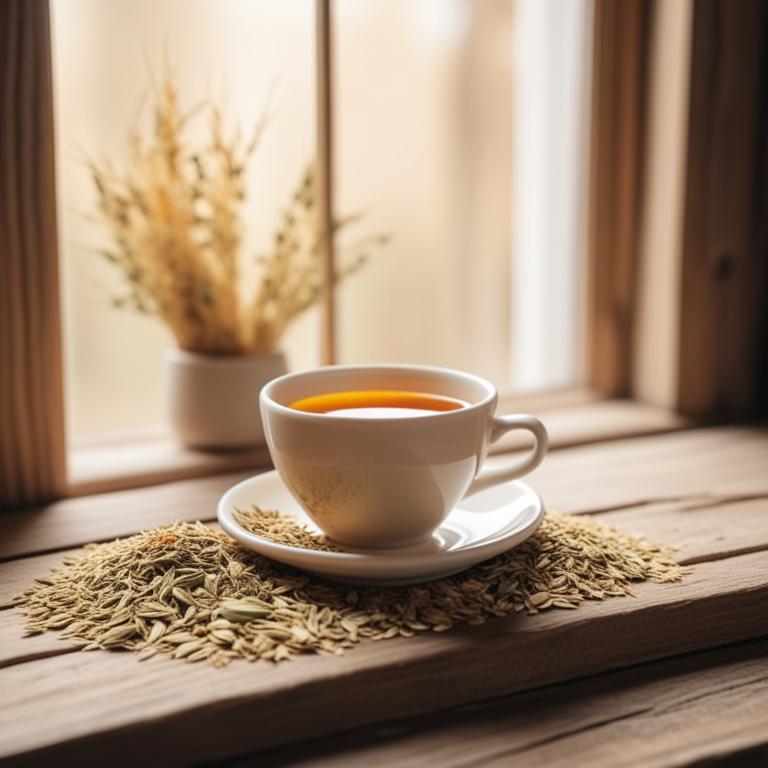
Avena sativa teas contains a compound called avenacoside, which is a powerful antioxidant.
This antioxidant helps to reduce inflammation and stress on the body, common symptoms experienced during menopause. Avena sativa also contains avenanthramides, which have a calming effect on the nervous system, reducing anxiety and hot flashes associated with menopause. The apigenin and avenalumic acid found in Avena sativa teas have anti-inflammatory properties that help to alleviate vaginal dryness and night sweats.
By reducing inflammation and promoting relaxation, Avena sativa teas provide relief from common menopause symptoms.
- Gather 1 tablespoon of Avena sativa dried herb, 1 cup of boiling water, and a tea infuser or strainer.
- Pour boiling water over the Avena sativa herb in the tea infuser or strainer.
- Let the mixture steep for 5-7 minutes, then remove the tea infuser or strainer.
- Strain the tea into a cup, if needed, and discard the solids.
- Drink the tea hot or cold, as desired, up to 3 times a day as needed.
9. Angelica sinensis

Angelica sinensis teas contains bioactive constituents like ferulic acid, isorhapontigenin, and ligustilide.
These compounds have anti-inflammatory and antioxidant properties. The ferulic acid and isorhapontigenin help to regulate hormonal balance, which is often disrupted during menopause. The ligustilide has a relaxing effect on the uterine muscles, reducing hot flashes and night sweats.
The combination of these properties in Angelica sinensis teas makes it a valuable herbal remedy for managing menopause symptoms.
- Gather 2 tablespoons of dried Angelica sinensis root and 1 cup of boiling water.
- Place the Angelica sinensis root in a teapot or infuser.
- Pour in the boiling water and let it steep for 5-7 minutes.
- Strain the tea into a cup and add honey to taste, if desired.
- Drink the tea 2-3 times a day, or as directed by a healthcare professional.